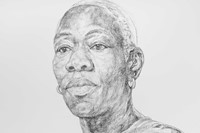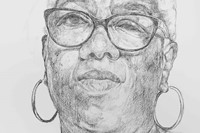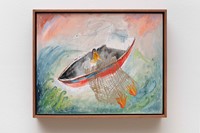Featuring the work of Barbara Walker, Jesse Darling, Rory Pilgrim, and Ghislaine Leung, this year’s Turner Prize is about “humanity and vulnerability”, says curator Noelle Collins
The Turner Prize’s 2023 exhibition is now open, celebrating the work of four British artists at Towner Eastbourne on the English south coast. This year’s nominees are: Barbara Walker, showing intricate charcoal drawings of people from the Windrush Generation whose immigration status has been challenged by the government; Jesse Darling, with a multi-artwork installation highlighting the precarities and partitions of contemporary British life; Rory Pilgrim, sharing an expanded video project which features residents of Barking and Dagenham reflecting on the pandemic, mental health and community; and Ghislaine Leung, featuring a selection of conceptual works interrogating the politics and processes of artistic production.
“When viewing and thinking about these artists’ work, words like humanity and vulnerability are at the forefront of my mind,” says Tower Eastbourne’s Noelle Collins, who has curated the Turner Prize show. “I hope that through sharing these exhibitions we can be guided by each of the artists, inspired by their work, encouraged to consider different perspectives, moved by their experiences and the stories of their sitters and collaborators.”
Barbara Walker’s practice is perhaps one of the most directly collaborative. For Burden of Proof, the artist worked with five people whose lives have been impacted by the 2017 Windrush Scandal. Each had their lawful immigration status challenged by the government, which incorrectly labelled them as undocumented migrants. At Towner Eastbourne, the artist has recreated their likeness directly onto one wall in commanding charcoal drawings which play with the idea of visibility. Here, they are highly visible and rendered using a labour-intensive technique, but their images will be erased from the walls when the show ends.
Each person is also depicted by Walker in wall-hung drawings, with their portraits merging into charcoal reproductions of the official documents that enabled them to confirm their legal status in the country, from employment reference letters to notices of discharge from military service. The documents – especially the personalised letters – highlight the generosity and value of these individuals to a society that questions their place and authenticity.
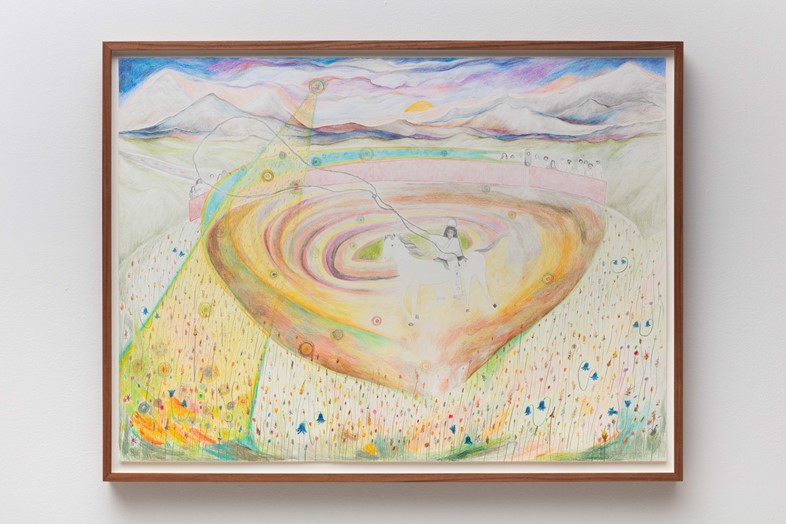
In the adjoining room, Jesse Darling’s installation of sculptural works depicts a state in disarray, with a ragged maypole in the centre of the room, barbed wire checkpoints eerily surrounding the doorways, and buckled metal pedestrian barriers winding through the gallery. Everything feels as though it could collapse or break at any second: industrial shelving units bend under the weight of concrete-filled folders; a twisted roller-coaster track smashes its way through the back wall. The materials connect with spaces of labour rather than domesticity, and the abandoned, chaotic scene suggests an act of rebellion against the system that had already happened.
Downstairs, Rory Pilgrim’s Raft combines an hour-long film installation with small-scale paintings, which have an innocent dreaminess to them, covered in glitter and rendered in rainbow tones and soft marks. The film features eight people from Barking and Dagenham’s Green Shoes Arts, each sharing stories of loneliness, loss, and recovery. The artist draws together sections of song, poetry, dance, and interview, considering the idea of a raft as something lifesaving but also precarious. Made during the Covid-19 pandemic, the film is woven through with a sense of grief that still permeates in 2023, as people talk about losing work, make connections with a floundering natural world, and detail ongoing struggles with their mental health. While the work tackles deeply ingrained social injustices, there is a hopefulness to it too, celebrating the beauty of nature and the potential for healing when communities find ways to connect.
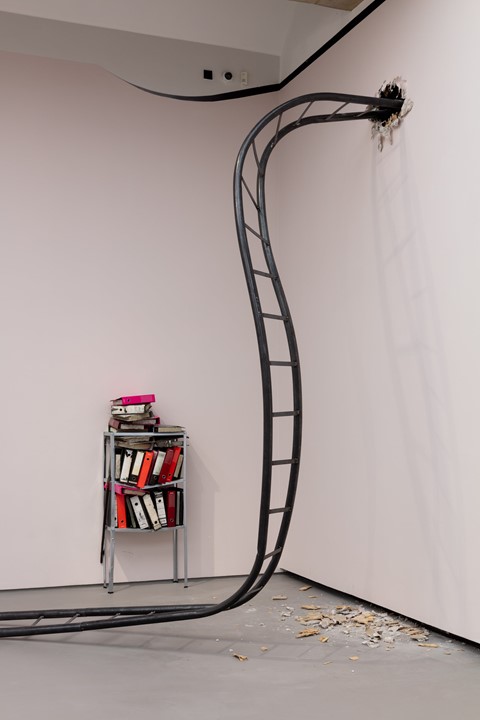
On the ground floor, Ghislaine Leung’s work is the most inward-looking of the four, exploring the conditions and production of art. A baby monitor installed in the gift shop feeds through to the gallery space, addressing the demanding dual labour of motherhood and art making. A system of giant metal pipes dominates the room, formed from Netwerk Aalst Bar’s ventilation system removed during restoration and resituated in Towner Eastbourne, connecting the physical space of the two institutions. A large fountain towards the back of the gallery envelops visitors with the rhythmic sound of water running and splashing, altering their sensory experience.
The 2023 Turner Prize will be judged by Camden Arts Centre’s Martin Clark; Cédric Fauq, chief curator of CAPC Musée d’art Contemporain de Bordeaux; director of the Wellcome Collection, Melanie Keen; and Helen Nisbet, the artistic director of Art Night. The winner will be announced on December 8. Throughout the exhibition, the experience of being a single human trying to operate within a messy and cold system is evoked. While this is a highly relevant theme on a global scale, it feels particularly pertinent within a post-Brexit, post-pandemic Britain, which is still struggling to come to terms with its 21st-century identity.
The Turner Prize 2023 is on show at Towner Eastbourne in Eastbourne until 14 April 2024.

